recommended oil KIA STONIC 2018 Owners Manual
[x] Cancel search | Manufacturer: KIA, Model Year: 2018, Model line: STONIC, Model: KIA STONIC 2018Pages: 523, PDF Size: 24.99 MB
Page 9 of 523
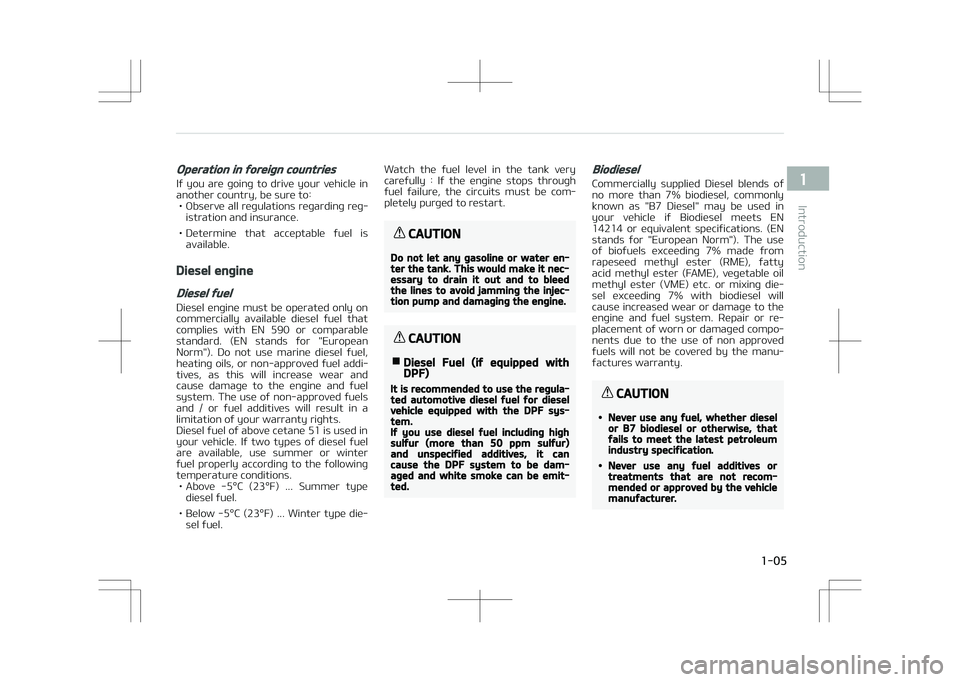
Operation in foreign countries
If you are going to drive your vehicle in
another country, be sure to: • Observe all regulations regarding reg‐ istration and insurance.
• Determine that acceptable fuel is available.
Diesel engine
Diesel fuel
Diesel engine must be operated only on
commercially available diesel fuel that
complies with EN 590 or comparable standard. (EN stands for "European
Norm"). Do not use marine diesel fuel,
heating oils, or non-approved fuel addi‐ tives, as this will increase wear and
cause damage to the engine and fuel
system. The use of non-approved fuels and / or fuel additives will result in a
limitation of your warranty rights.
Diesel fuel of above cetane 51 is used in
your vehicle. If two types of diesel fuel
are available, use summer or winter fuel properly according to the following
temperature conditions. • Above -5°C (23°F) ... Summer type diesel fuel.
• Below -5°C (23°F) ... Winter type die‐ sel fuel. Watch the fuel level in the tank very
carefully : If the engine stops through
fuel failure, the circuits must be com‐
pletely purged to restart.
CAUTION
Do not let any gasoline or water en‐ter the tank. This would make it nec‐essary to drain it out and to bleedthe lines to avoid jamming the injec‐tion pump and damaging the engine.
CAUTION
nDiesel Fuel (if equipped withDPF)
It is recommended to use the regula‐ted automotive diesel fuel for dieselvehicle equipped with the DPF sys‐tem.If you use diesel fuel including highsulfur (more than 50 ppm sulfur)and unspecified additives, it cancause the DPF system to be dam‐aged and white smoke can be emit‐ted.
Biodiesel
Commercially supplied Diesel blends of
no more than 7% biodiesel, commonly
known as "B7 Diesel" may be used in your vehicle if Biodiesel meets EN
14214 or equivalent specifications. (EN
stands for "European Norm"). The use of biofuels exceeding 7% made from
rapeseed methyl ester (RME), fatty
acid methyl ester (FAME), vegetable oil methyl ester (VME) etc. or mixing die‐
sel exceeding 7% with biodiesel will
cause increased wear or damage to the engine and fuel system. Repair or re‐
placement of worn or damaged compo‐
nents due to the use of non approved fuels will not be covered by the manu‐
factures warranty.
CAUTION
•Never use any fuel, whether dieselor B7 biodiesel or otherwise, thatfails to meet the latest petroleumindustry specification.
•Never use any fuel additives ortreatments that are not recom‐mended or approved by the vehiclemanufacturer.
1-05
1
Introduction
Page 151 of 523
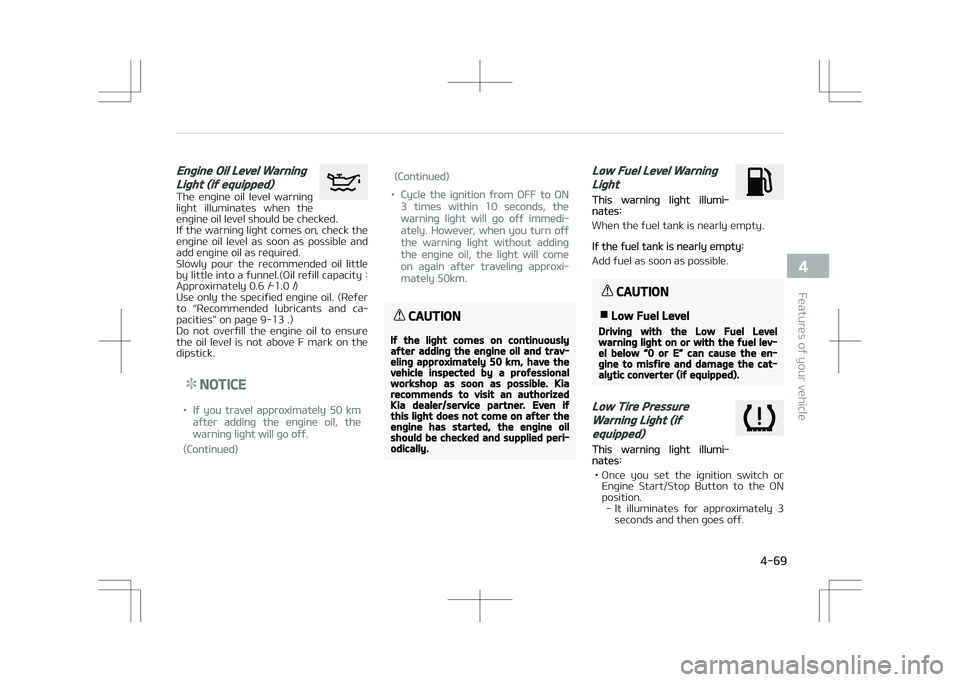
Engine Oil Level Warning
Light (if equipped)
The engine oil level warninglight illuminates when the
engine oil level should be checked.
If the warning light comes on, check the engine oil level as soon as possible and
add engine oil as required.
Slowly pour the recommended oil little
by little into a funnel.(Oil refill capacity : Approximately 0.6
l~1.0 l)
Use only the specified engine oil. (Refer
to L
Page 348 of 523
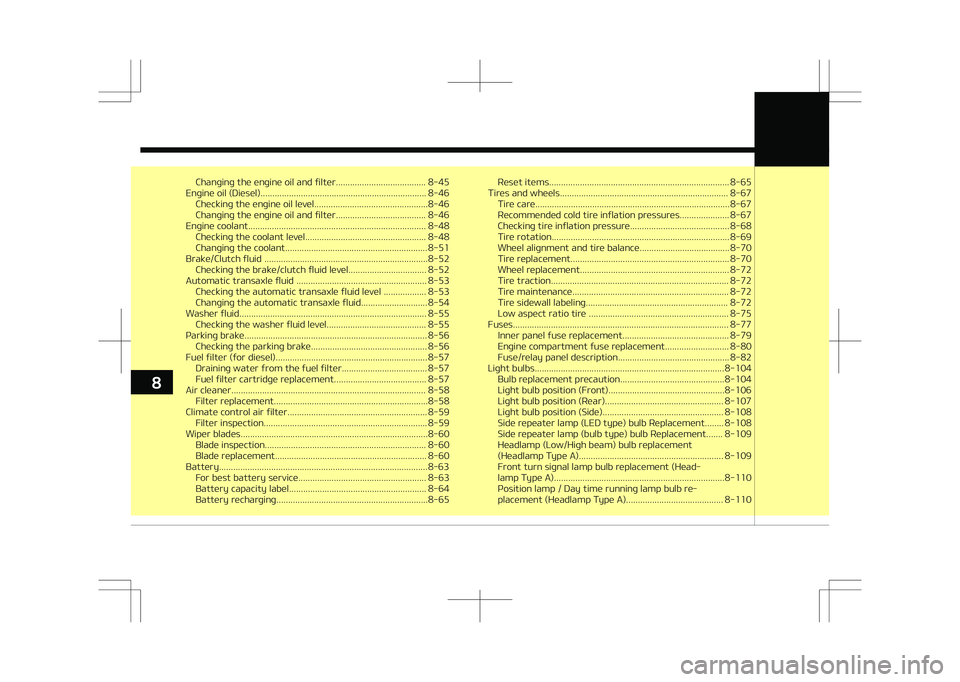
Changing the engine oil and filter...................................... 8-45
Engine oil (Diesel)...................................................................... 8-46 Checking the engine oil level................................................8-46
Changing the engine oil and filter...................................... 8-46
Engine coolant........................................................................... 8-48 Checking the coolant level................................................... 8-48
Changing the coolant............................................................ 8-51
Brake/Clutch fluid .....................................................................8-52 Checking the brake/clutch fluid level................................. 8-52
Automatic transaxle fluid ....................................................... 8-53 Checking the automatic transaxle fluid level .................. 8-53
Changing the automatic transaxle fluid............................ 8-54
Washer fluid............................................................................... 8-55 Checking the washer fluid level.......................................... 8-55
Parking brake............................................................................. 8-56 Checking the parking brake................................................. 8-56
Fuel filter (for diesel)................................................................ 8-57 Draining water from the fuel filter.................................... 8-57
Fuel filter cartridge replacement....................................... 8-57
Air cleaner.................................................................................. 8-58 Filter replacement.................................................................8-58
Climate control air filter........................................................... 8-59 Filter inspection..................................................................... 8-59
Wiper blades...............................................................................8-60 Blade inspection.................................................................... 8-60
Blade replacement................................................................ 8-60
Battery........................................................................................8-63 For best battery service...................................................... 8-63
Battery capacity label.......................................................... 8-64
Battery recharging................................................................8-65 Reset items............................................................................ 8-65
Tires and wheels....................................................................... 8-67 Tire care.................................................................................. 8-67
Recommended cold tire inflation pressures..................... 8-67
Checking tire inflation pressure.......................................... 8-68
Tire rotation........................................................................... 8-69
Wheel alignment and tire balance...................................... 8-70
Tire replacement................................................................... 8-70
Wheel replacement............................................................... 8-72
Tire traction........................................................................... 8-72
Tire maintenance.................................................................. 8-72
Tire sidewall labeling............................................................ 8-72
Low aspect ratio tire ........................................................... 8-75
Fuses........................................................................................... 8-77 Inner panel fuse replacement............................................. 8-79
Engine compartment fuse replacement........................... 8-80
Fuse/relay panel description............................................... 8-82
Light bulbs................................................................................8-104 Bulb replacement precaution............................................8-104
Light bulb position (Front).................................................8-106
Light bulb position (Rear).................................................. 8-107
Light bulb position (Side)................................................... 8-108
Side repeater lamp (LED type) bulb Replacement........ 8-108
Side repeater lamp (bulb type) bulb Replacement....... 8-109
Headlamp (Low/High beam) bulb replacement
(Headlamp Type A)............................................................. 8-109
Front turn signal lamp bulb replacement (Head‐
lamp Type A)........................................................................8-110
Position lamp / Day time running lamp bulb re‐
placement (Headlamp Type A)......................................... 8-110
8
Page 374 of 523
![KIA STONIC 2018 Owners Manual Normal Maintenance Schedule - For Diesel Engine [For Europe (Except Russia)]
The following maintenance services must be performed to ensure good emission control and performance. Keep r KIA STONIC 2018 Owners Manual Normal Maintenance Schedule - For Diesel Engine [For Europe (Except Russia)]
The following maintenance services must be performed to ensure good emission control and performance. Keep r](/img/2/40480/w960_40480-373.png)
Normal Maintenance Schedule - For Diesel Engine [For Europe (Except Russia)]
The following maintenance services must be performed to ensure good emission control and performance. Keep receipts for
all vehicle emission services to protect your warranty. Where both mileage and time are shown, the frequency of service is determined by whichever occurs first.
NO.ITEMREMARK
*1 Engine oil and engine oil filter Check the engine oil level and leak every 500 km (350 miles) or before start‐ ing a long trip.
*2 Engine oil and engine oil filter (For
Diesel Engine) • If the recommended oil is not available, replace engine oil and engine oil fil‐
ter every 20,000 km or 12 months.
• The engine oil level should be checked regularly and maintained properly. Operating with an insufficient amount oil can damage the engine, and such
damage is not covered by warranty.
• This maintenance schedule depends on fuel quality. It is applicable only when using a qualified fuel <"EN590 or equivalent">. If the diesel fuel speci‐
fications don't meet the EN590, it must be replaced according to the severe maintenance schedule.
*3 Coolant (Engine) When adding coolant, use only deionized water or soft water for your vehicle
and never mix hard water in the coolant filled at the factory. An improper
coolant mixture can result in serious malfunction or engine damage.
*4 Drive belts (Engine) • Adjust alternator, water pump and air conditioner (if equipped) drive belt.
Inspect and if necessary repair or replace.
• Inspect drive belt tensioner, idler and alternator pulley and if necessary cor‐ rect or replace.
*5 Manual transaxle fluid Manual transaxle fluid should be changed anytime it has been submerged in
water.
Maintenance
8-28
Page 411 of 523
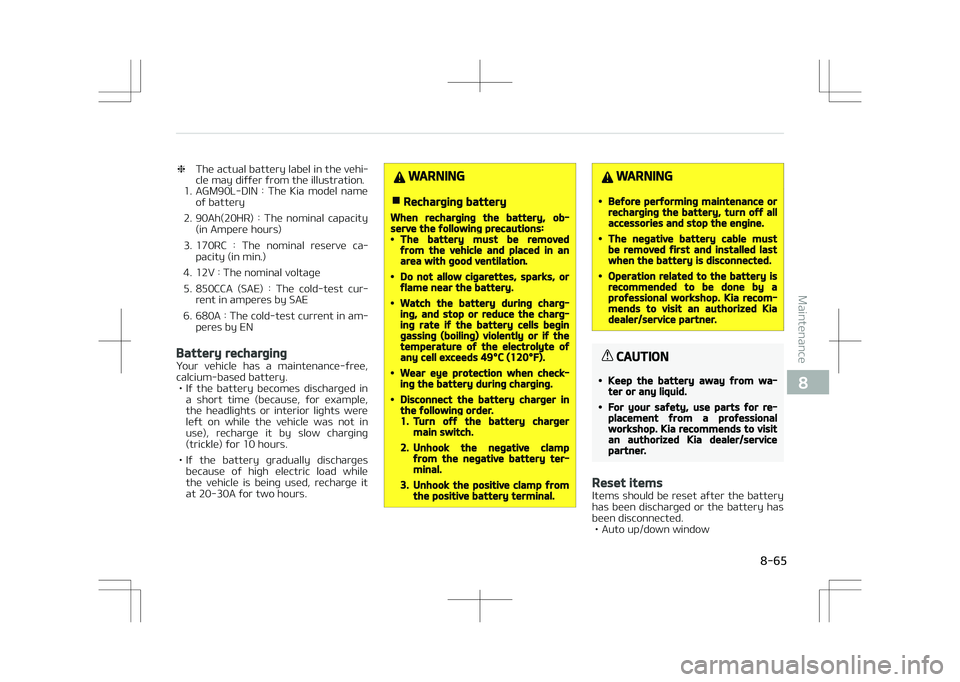
❈The actual battery label in the vehi‐
cle may differ from the illustration.
1. AGM90L-DIN : The Kia model name
of battery
2. 90Ah(20HR) : The nominal capacity (in Ampere hours)
3. 170RC : The nominal reserve ca‐ pacity (in min.)
4. 12V : The nominal voltage
5. 850CCA (SAE) : The cold-test cur‐ rent in amperes by SAE
6. 680A : The cold-test current in am‐ peres by EN
Battery recharging
Your vehicle has a maintenance-free,
calcium-based battery. • If the battery becomes discharged in a short time (because, for example,the headlights or interior lights were
left on while the vehicle was not in
use), recharge it by slow charging
(trickle) for 10 hours.
• If the battery gradually discharges because of high electric load while
the vehicle is being used, recharge it
at 20-30A for two hours.
WARNING
nRecharging battery
When recharging the battery, ob‐serve the following precautions:•The battery must be removedfrom the vehicle and placed in anarea with good ventilation.
•Do not allow cigarettes, sparks, orflame near the battery.
•Watch the battery during charg‐ing, and stop or reduce the charg‐ing rate if the battery cells begingassing (boiling) violently or if thetemperature of the electrolyte ofany cell exceeds 49°C (120°F).
•Wear eye protection when check‐ing the battery during charging.
•Disconnect the battery charger inthe following order.1.Turn off the battery chargermain switch.
2.Unhook the negative clampfrom the negative battery ter‐minal.
3.Unhook the positive clamp fromthe positive battery terminal.
WARNING
•Before performing maintenance orrecharging the battery, turn off allaccessories and stop the engine.
•The negative battery cable mustbe removed first and installed lastwhen the battery is disconnected.
•Operation related to the battery isrecommended to be done by aprofessional workshop. Kia recom‐mends to visit an authorized Kiadealer/service partner.
CAUTION
•Keep the battery away from wa‐ter or any liquid.
•For your safety, use parts for re‐placement from a professionalworkshop. Kia recommends to visitan authorized Kia dealer/servicepartner.
Reset items
Items should be reset after the battery
has been discharged or the battery has been disconnected. • Auto up/down window
8-65
8
Maintenance
Page 479 of 523

Fabric seat cover using precautions
(If equipped)
Please clean the fabric seats regularly
with a vacuum cleaner in consideration of fabric material characteristics. If
they are heavily soiled with beverage
stains, etc., use a suitable interior cleaner. To prevent damage to seat
covers, wipe off the seat covers down
to the seams with a large wiping mo‐ tion and moderate pressure using a
soft sponge or microfiber cloth. Velcro
closures on clothing or sharp objects may cause snagging or scratches on
the surface of the seats. Make sure not
to rub such objects against the surface.
Cleaning the upholstery and
interior trim
Vinyl
Remove dust and loose dirt from vinyl
with a whisk broom or vacuum cleaner. Clean vinyl surfaces with a vinyl clean‐
er.
Fabric
Remove dust and loose dirt from fabric
with a whisk broom or vacuum cleaner. Clean with a mild soap solution recom‐
mended for upholstery or carpets. Re‐
move fresh spots immediately with a fabric spot cleaner. If fresh spots do
not receive immediate attention, the
fabric can be stained and its color can be affected. Also, its fire-resistant
properties can be reduced if the mate‐
rial is not properly maintained.
CAUTION
Using anything but recommendedcleaners and procedures may affectthe fabric’s appearance and fire-re‐sistant properties.
Cleaning the lap/shoulder belt
webbing
Clean the belt webbing with any mild
soap solution recommended for clean‐ ing upholstery or carpet. Follow the in‐
structions provided with the soap. Do
not bleach or re-dye the webbing be‐ cause this may weaken it.
Cleaning the interior window glass
If the interior glass surfaces of the ve‐
hicle become fogged (that is, covered
with an oily, greasy or waxy film), they should be cleaned with glass cleaner.
Follow the directions on the glass
cleaner container.
CAUTION
Do not scrape or scratch the insideof the rear window. This may resultin damage to the rear window de‐froster grid.
8-133
8
Maintenance
Page 495 of 523
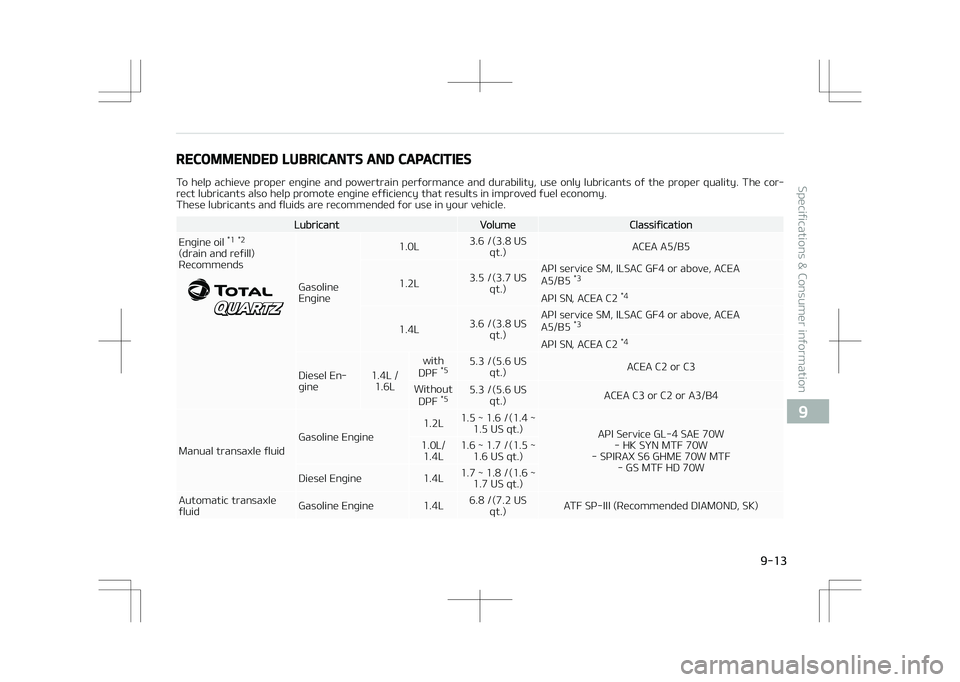
RECOMMENDED LUBRICANTS AND CAPACITIES
To help achieve proper engine and powertrain performance and durability, use only lubricants of the proper quality. The cor‐
rect lubricants also help promote engine efficiency that results in improved fuel economy.
These lubricants and fluids are recommended for use in your vehicle.
LubricantVolumeClassification
Engine oil *1
*2
(drain and refill)
Recommends
Gasoline Engine 1.0L
3.6
l (3.8 US
qt.) ACEA A5/B5
1.2L 3.5
l (3.7 US
qt.) API service SM, ILSAC GF4 or above, ACEA A5/B5
*3
API SN, ACEA C2 *4
1.4L 3.6
l (3.8 US
qt.) API service SM, ILSAC GF4 or above, ACEAA5/B5
*3
API SN, ACEA C2 *4
Diesel En‐ gine 1.4L /
1.6L with
DPF *5 5.3
l (5.6 US
qt.) ACEA C2 or C3
Without DPF *5 5.3
l (5.6 US
qt.) ACEA C3 or C2 or A3/B4
Manual transaxle fluid Gasoline Engine 1.2L
1.5 ~ 1.6
l (1.4 ~
1.5 US qt.) API Service GL-4 SAE 70W
- HK SYN MTF 70W
- SPIRAX S6 GHME 70W MTF - GS MTF HD 70W
1.0L/
1.4L 1.6 ~ 1.7
l (1.5 ~
1.6 US qt.)
Diesel Engine 1.4L 1.7 ~ 1.8
l (1.6 ~
1.7 US qt.)
Automatic transaxlefluid Gasoline Engine 1.4L 6.8
l (7.2 US
qt.) ATF SP-III (Recommended DIAMOND, SK)
9-13
9
Specifications & Consumer information
Page 497 of 523
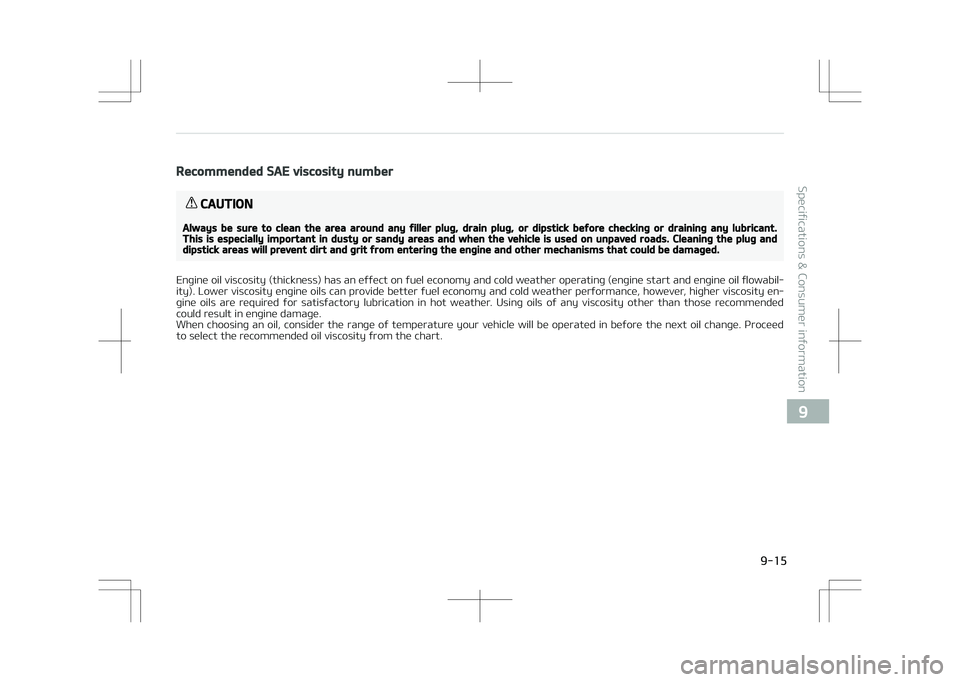
Recommended SAE viscosity number
CAUTION
Always be sure to clean the area around any filler plug, drain plug, or dipstick before checking or draining any lubricant.This is especially important in dusty or sandy areas and when the vehicle is used on unpaved roads. Cleaning the plug anddipstick areas will prevent dirt and grit from entering the engine and other mechanisms that could be damaged.
Engine oil viscosity (thickness) has an effect on fuel economy and cold weather operating (engine start and engine oil flowabil‐
ity). Lower viscosity engine oils can provide better fuel economy and cold weather performance, however, higher viscosity en‐ gine oils are required for satisfactory lubrication in hot weather. Using oils of any viscosity other than those recommended
could result in engine damage.
When choosing an oil, consider the range of temperature your vehicle will be operated in before the next oil change. Proceed to select the recommended oil viscosity from the chart.
9-15
9
Specifications & Consumer information